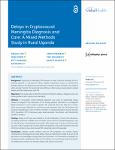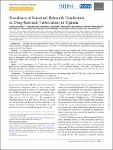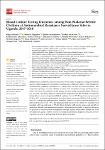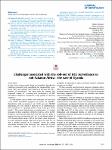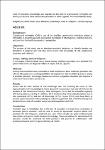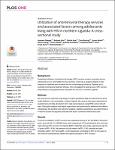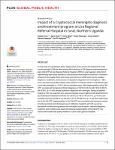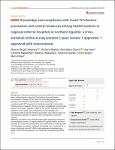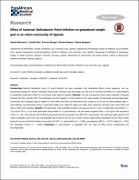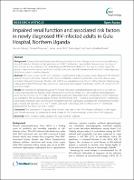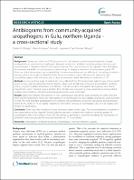Department of Internal Medicine
Browse by
Recent Submissions
-
Poor long-term outcomes despite improved hospital survival for patients with cryptococcal meningitis in rural, Northern Uganda
(PLoS ONE, 2024)Background Cryptococcal meningitis (CM) remains a major cause of death among people living with HIV in rural sub-Saharan Africa. We previously reported that a CM diagnosis and treatment program (CM-DTP) improved hospital ... -
Delays in Cryptococcal Meningitis Diagnosis and Care: A Mixed Methods Study in Rural Uganda
(Annals of global health,, 2022)Background: Cryptococcal meningitis (CM) remains a major cause of mortality for HIV infected persons in sub-Saharan Africa, despite widespread access to antiretroviral therapy. Delays in CM diagnosis and treatment ... -
Prevalence of Intestinal Helminth Coinfection in Drug-Resistant Tuberculosis in Uganda
(Oxford University Press., 2022)Background. Although a third of people with tuberculosis (TB) are estimated to be coinfected with helminths, the prevalence is largely unknown among people with drug-resistant TB (DR-TB). We determined the prevalence of ... -
Blood Culture Testing Outcomes among Non-Malarial Febrile Children at Antimicrobial Resistance Surveillance Sites in Uganda, 2017–2018
(Tropical Medicine and Infectious Disease, 2021): Blood culture (BC) processes are critical to the utility of diagnostic testing, bloodstream infection (BSI) management, and antimicrobial resistance (AMR) surveillance. While Uganda has established BC guidelines, often ... -
High Burden of Cryptococcal Meningitis Among Antiretroviral Therapy–Experienced Human Immunodeficiency Virus–Infected Patients in Northern Uganda in the Era of “Test and Treat”: Implications for Cryptococcal Screening Programs
(Open forum infectious diseases, 2022)Background. The impact of the “test and treat” program for human immunodeficiency virus (HIV) treatment in rural areas of Uganda on cryptococcal antigen (CrAg) screening or cryptococcal meningitis (CM) is poorly ... -
Challenges associated with the roll-out of HCC surveillance in sub-Saharan Africa - the case of Uganda
(Journal of Hepatology, 2020)In sub-Saharan Africa, where HBV infections are the main cause of HCC, surveillance programs are mostly not available.2 Nonetheless, with an incidence rate of 8.9 cases per 100,000 inhabitants per year, which is likely ... -
Lack of education, knowledge, and supplies are barriers to cryptococcal meningitis care among nurses and other healthcare providers in rural Uganda: A mixed methods study
(Nurse Education Today, 2023)Abstract Background Cryptococcal meningitis (CM) is one of the deadliest opportunistic infections related to HIV/AIDS. A research gap exists surrounding the barriers to CM diagnosis, treatment delivery, and care from ... -
Utilization of antiretroviral therapy services and associated factors among adolescents living with HIV in northern Uganda: A cross-sectional study
(PLoS ONE, 2023)Background Suboptimal utilization of antiretroviral therapy (ART) services remains a problem among adolescents in low- and middle-income countries, which has a negative impact on their response to treatment and increases ... -
Impact of a Cryptococcal meningitis diagnosis and treatment program at Lira Regional Referral Hospital in rural, Northern Uganda
(PLOS global public health, 2022)Abstract In rural areas of sub-Saharan Africa, infrastructure and resources for treatment of crypto coccal meningitis (CM) are often lacking. We introduced a CM diagnosis and treatment pro gram (CM-DTP) at Lira Regional ... -
Knowledge and compliance with Covid-19 infection prevention and control measures among health workers in regional referral hospitals in northern Uganda: a cross sectional online survey [version 2; peer review: 1 approved, 1 approved with reservations]
(F1000Research, 2021)Background: Infection prevention and control (IPC) has increasingly been underscored as a key tool for limiting the transmission of coronavirus disease 2019 (Covid-19) and safeguarding health workers from infections ... -
Improving the accuracy of heart failure diagnosis in low-resource settings through task sharing and decentralization
(Global Health Action, 2019)Background: Task sharing of TTE may improve capacity for heart failure diagnosis and management in patients in remote, low-resource settings but the impact on diagnostic accuracy and patient outcomes has not been ... -
Effect of maternal Helicobacter Pylori infection on gestational weight gain in an urban community of Uganda
(The Pan African Medical Journal, 2017)Introduction: Maternal Helicobacter pylori (H. pylori) infection has been associated with undesirable effects during pregnancy such as; hyperemesis gravidarum, anemia, intrauterine fetal growth restriction and miscarriage. ... -
Impaired renal function and associated risk factors in newly diagnosed HIV-infected adults in Gulu Hospital, Northern Uganda
(BMC nephrology, 2015)Background: Screening for renal diseases should be performed at the time of diagnosis of human immunodeficiency virus (HIV) infection. Despite the high prevalence of HIV/AIDS in Northern Uganda, little is known about the ... -
Are Women In Low Income Setting Gaining Adequate Gestational Weight? A Prospective Cross Sectional Study In Urban Uganda
(School of Biological Sciences, 2016)Introduction: Pre-pregnancy weight and weight gained during pregnancy significantly influence maternal and infant health. Little information is available regarding prevalence of optimal GWG in relation to pre-pregnancy body ... -
Health seeking behaviour of small income market vendors: Diabetes primary care in Gulu Municipality, northern Uganda
(South Sudan Medical Journal, 2020)Introduction: Uganda faces a serious threat of non-communicable diseases including type 2 diabetes; sedentary lifestyles predispose people to these diseases. Objective: To understand the diabetes health seeking behaviour ... -
Antibiograms from community-acquired uropathogens in Gulu, northern Uganda - a cross-sectional study
(BMC infectious diseases, 2013)Background: Urinary tract infections (UTI) are common in clinical practice and empirical treatment is largely employed due to predictability of pathogens. However, variations in antibiotic sensitivity patterns do occur, ... -
Prevalence of anaemia and associated risk factors among pregnant women attending antenatal care in Gulu and Hoima Regional Hospitals in Uganda: A cross sectional study
(BMC pregnancy and childbirth, 2016)Background: Anaemia is a public health problem affecting over 1.62 billion people globally. It affects all age groups of people and is particularly more prevalent in pregnant women. Africa carries a high burden of ...


